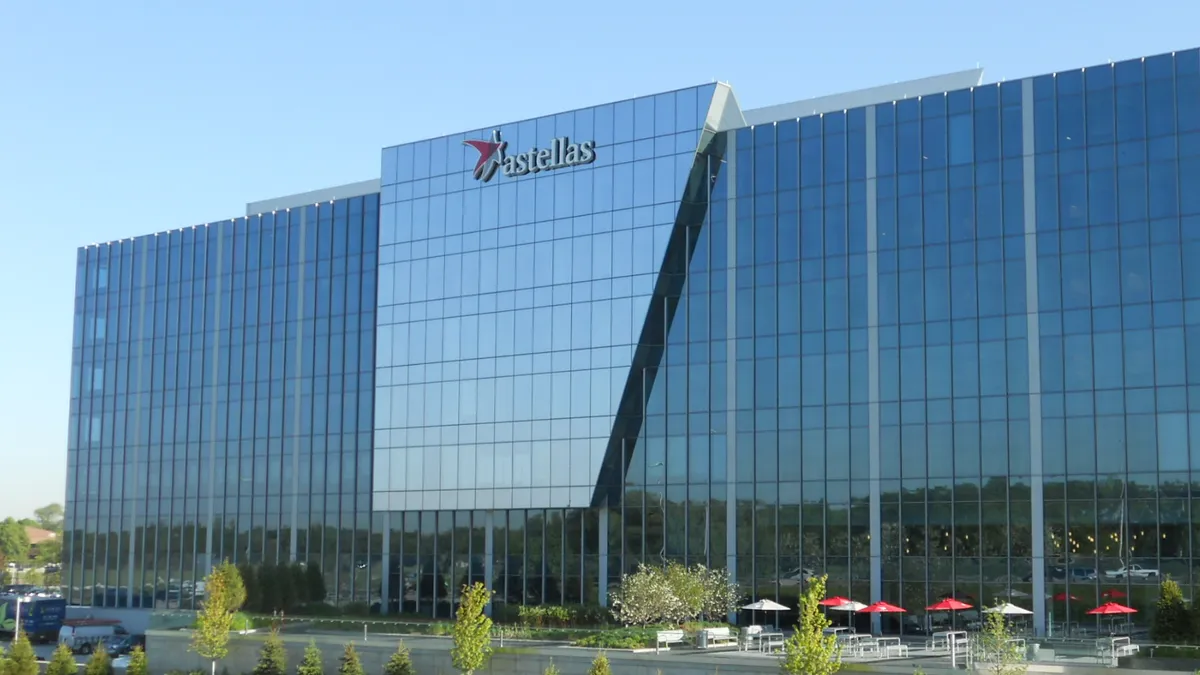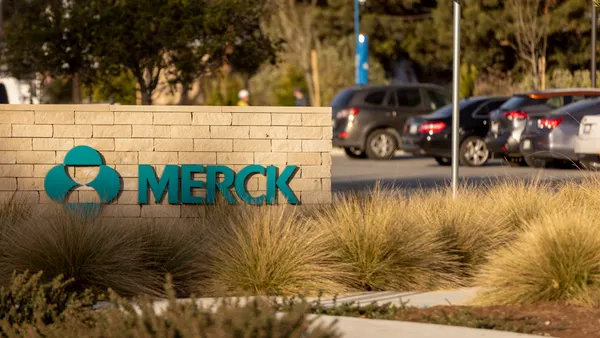“2023 for Astellas is a very important year,” said Mark Reisenauer, the company’s U.S. president.
If all goes right, the multinational Japanese pharma — most known for its oncology and urology drugs — could add two first-in-class therapies to its growing list of commercialized medicines and expand indication areas for two of its existing cancer drugs over the next 12 months.

On the oncology side of its business, Reisenauer said the company has a long history of chasing “difficult to treat cancers.” Along those lines, Astellas is hoping to launch zolbetuximab by the end of 2023 to treat locally advanced as well as metastatic gastric cancer — an indication with a five-year survival rate of only 6% that is currently treated with surgery and chemotherapy.
The drug, acquired through Astellas’ 2016 buyout of the German-based Ganymed, is on the cutting edge of cancer research. The monoclonal antibody zeroes in on the Claudin18.2 protein, a molecular target first discovered by BioNTech founders Özlem Türeci and her husband Uğur Şahi who were on the hunt for new methods of treating solid tumors. Its cousin, Claudin6, has also drawn interest from several biotech and pharma companies, including BioNTech — who circled back to the approach after selling Ganymed to Astellas — as a potential solid tumor target for CAR-T therapies.
In results published Thursday from Astellas’ Spotlight trial, which tested the drug in combination with the chemotherapy regimen mFOLFOX6, zolbetuximab was found to substantially reduce the risk of death and disease progression.
"Much like what we did in oncology 10 or 15 years ago, where we really committed to that therapeutic area ... we’re taking a similar strategic and holistic approach to building out those (gene and cell) capabilities."

Mark Reisenauer
President, Astellas
But Astellas is also looking to expand its footprint past oncology in 2023 into women’s health and other indications, Reisenauer said. In February, the FDA is slated to review Astellas’ novel non-hormonal treatment to reduce the frequency and severity of vasomotor symptoms (VMS), characterized by severe hot flashes and night sweats, in menopausal women.
VMS has historically been treated with a hormone therapy linked to increased risk of endometrial cancer, blood clots and heart attacks, so the market for alternatives is heating up, and is expected to grow from its current value of $16.71 billion to over $27 billion by 2030. Bayer is also in the midst of a phase 3 trial for a similar candidate to Astellas’ drug, and has pegged the drug as a potential blockbuster.
These potential milestones follow what was a tumultuous 2022 for Astellas, marked by myriad setbacks particularly in its fledgling gene and cell therapy business — which saw two therapies put on FDA clinical holds and the discontinuation of several programs for Duchenne muscular dystrophy, together leading to $700 million in impairment losses for the company.
On Friday the FDA lifted one of those holds for the company’s phase 1/2 candidate in late-onset Pompe disease. Astellas’ said in a statement that it is “working on completing the clinical and regulatory activities necessary to resume dosing” in that trial. Prior to that FDA decision, Reisenauer also told PharmaVoice that Astellas’ expects to continue “looking for ways to augment” that business in 2023.
“We believe (2023) is going to be an inflection point in our growth,” Reisenauer said. “We're not a large pharmaceutical company, we're a mid-sized pharma company. And to have two first-in-class launches in the same year, I think is significant. Not only is it an accomplishment, but I think it's a testament to the innovation and the R&D work that we're doing.”
With major changes afoot, Reisenauer gave PharmaVoice a peek at why he’s preparing for a “very busy year” ahead.
This interview has been edited for brevity and style.
PHARMAVOICE: How is your candidate for VMS, fezolinetant, different from other non-hormonal treatments on the market?
MARK REISENAUER: It's a new mechanism. The KNDy neuron is a neuron that's responsible for regulating body temperature. So fezolinetant blocks neurokinin B (NKB), binding on the KNDY neuron to moderate neuronal activity in the thermoregulatory center of the brain. We're the first-in-class and there are others coming as well. But this is a very novel approach.
One of the things that we've been doing is just trying to understand the condition better and the unmet need. We’ve also spent a lot of time this year educating the marketplace, both physicians and patients, about vasomotor symptoms because it's an area that people have forgotten about. You had hormone therapy years ago, and due to some of the health-related issues, people moved away from that as a mainstay. But there really hasn't been a good alternative. So we think there's a significant need here.
You mentioned that there is competition for fezolinetant coming down the pipes. Bayer has a similar drug targeting VMS for menopause in phase 3 trials. How is that competition impacting Astellas’ strategy?
The competition isn’t really impacting us. What we're looking to do is maximize the fact that we are first-to-market. That's actually a lot of why we've spent time a year ahead building disease state awareness to help with our uptake efforts.
In terms of our approach around commercialization, I won't give a lot of details at this point until we get approval. But it’s likely that there will still be some continuing education that's going to be required on the disease state. But certainly, once we get to commercialization, there'll be a very product-specific promotion as well.
What does the recent trial data published on the treatment zolbetuximab for gastric cancer mean for patients and for the company?
Zolbetuximab is another potential first-in-class candidate. We just announced results from two phase 3 trials in first-line gastric cancer late last year. One is called Spotlight, and that is looking at zolbetuximab in addition to the combination chemotherapy FOLFOX, versus chemotherapy plus placebo. Progression-free survival was the primary endpoint and the median progression-free survival on zolbetuximab was 10.61 months. The median progression-free survival for chemotherapy with the placebo was only 8.67 months. And then importantly, on survival, it was a similar improvement. The median overall survival was 18.23 months for zolbetuximab and only 15.54 months for chemotherapy plus the placebo.
There's another companion trial we call Glow. It has a similar design, but the base chemotherapy regimen is CAPOX which is capecitabine and oxaliplatin. So, it's a little bit of a different chemotherapy regimen. But the Glow trial also achieved both primary and secondary endpoints.
What are the next steps for zolbetuximab based on those results?
The filing will be at some point in fiscal year 2023 and then (we’re looking at) possible approval at some point potentially later in ‘23. In addition, in our oncology portfolio, we have two other potential launches that are also scheduled for 2023. One is with Padcev, which is our antibody-drug conjugate that targets Nectin-4. This is for advanced or metastatic urothelial, or bladder, cancer. It’s a first-line trial in combination with Keytruda and it is for patients who are ineligible to receive cisplatin in the frontline setting. The PDUFA date is April 21.
We're also waiting on the data from the Embark trial on Xtandi, and this is looking at high-risk nonmetastatic castration-sensitive (prostate cancer) patients. We're looking at top-line data sometime potentially in the first quarter of 2023.
On the gene therapy front, Astellas has faced several setbacks in the past year but you're continuing to invest in the area. What is fueling that confidence, and how is the company looking to overcome some of the challenges it has faced?
We've had some setbacks with some of the lead candidates with some clinical trial holds and we're working through those along with the FDA. But I think it's important to look at what we've been doing holistically in gene and cell therapy. We have over the past couple of years made a number of partnerships and acquisitions to build out all the capabilities we need to be successful in cell and gene therapy. We have various research approaches that we're developing. We have manufacturing capability — we just opened a manufacturing plant in Sanford, North Carolina. And we've even done some deals recently looking at ways to augment our gene and cell therapy research pipeline.
Much like what we did in oncology 10 or 15 years ago, where we really committed to that therapeutic area, we’re taking a similar strategic and holistic approach to building out those (gene and cell) capabilities.
What are some of the biggest challenges ahead for the company in 2023?
When you have potential launches, it's a flurry of activity and planning and execution. Like a lot of companies, we’re still trying to work through the hybrid work environment. I think one of the challenges is making sure that we strike the right balance as we're launching — that we're adapting appropriately and balancing that workload — especially because we have multiple launches. But this is a problem I would sign up for every day of the year, to have multiple potential launches like this.











